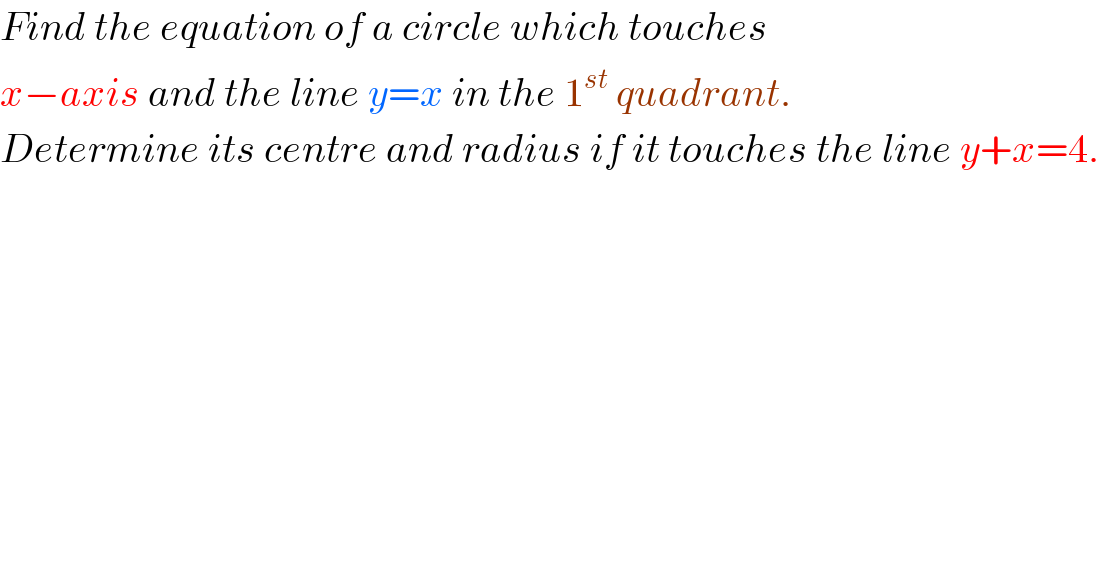
Question and Answers Forum
Question Number 116093 by Engr_Jidda last updated on 30/Sep/20

Answered by john santu last updated on 01/Oct/20

Commented by bemath last updated on 01/Oct/20

Commented by bemath last updated on 01/Oct/20

Answered by 1549442205PVT last updated on 02/Oct/20
![a)Suppose the equation of the circle C is (x−a)^2 +(y−b)^2 =R^2 .Since C touches the lines y=0 and y=x ,we infer the equations (x−a)^2 +b^2 =R^2 (1) and (x−a)^2 +(x−b)^2 =R^2 (2)has unique root (1)⇔x^2 −2ax+a^2 +b^2 −R^2 =0 with Δ′=a^2 −a^2 −b^2 +R^2 =R^2 −b^2 (2)⇔2x^2 −2(a+b)x+a^2 +b^2 −R^2 =0 with Δ′=(a+b)^2 −2a^2 −2b^2 +2R^2 =2R^2 −(a−b)^2 .Therefore,(1)(2)has unique root if and only if { ((R^2 −b^2 =0)),((2R^2 −(a−b)^2 =0)) :}⇔ { ((b=±R)),((a=±R±R(√2))) :} (∗) Hence,the equations of C are:(four cases) i)b=R⇒a=R(1±(√2))gives two the circles family: (x−R(1+(√2)))^2 +(y−R)^2 =R^2 . (x−R(1−(√2)))^2 +(y−R)^2 =R^2 ii)b=−R⇒a=R(−1±(√2))gives two the circles family: [x−R(−1+(√2))]^2 +(y+R)^2 =R^2 [(x−R(−1−(√2))]^2 +(y+R)^2 =R^2 Example,R=1,b=1,a=1+(√2) .... b)Now C touches to the x+y=4 if and only if the equation (x−a)^2 +(4−x−b)^2 =R^2 ⇔2x^2 −2(a−b+4)x+a^2 +(b−4)^2 −R^2 =0 has unique root. ⇔Δ′=(a−b+4)^2 −2a^2 −2(b−4)^2 +2R^2 =0 ⇔−a^2 +2(4−b)a−(4−b)^2 +2R^2 =0.From(∗)we get: ⇔−a^2 +8a−2ab−b^2 +8b−16+(a−b)^2 =0 ⇔4(2−b)a+8b−16=0 ⇔(2−b)a+2b−4=0(3) i)If b=2 then (3) is true⇒ R=2,a=2±2(√2) ii)If b≠2 then (3)⇔a=2 Replace into (∗)we get: R=(2/((1+(√2))))=2((√2)−1)=b,or R=(2/( (√2)−1))=2((√2)+1)=−b](Q116115.png)
